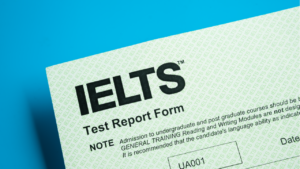The IELTS Speaking test is a crucial part of the IELTS examination. It assesses your English speaking skills in a one-on-one interview with a certified examiner. The test is conducted face-to-face. The Speaking test is divided into three parts, each assessing a different aspect of your speaking skills.
- Part 1 is an introduction and warm-up section where the examiner asks general questions about the candidate’s life, interests and hobbies.
- Part 2 is a two-minute monologue where you are given a cue card with a topic to speak about.
- Part 3 is a discussion between you and the examiner, involving in-depth questions related to the topic in Part 2.
The Speaking Test is conducted in a friendly and interactive manner, with the examiner encouraging you to speak freely and express your thoughts clearly. The test assesses your ability to communicate effectively in English, not your knowledge of the subject matter.
Leap Advantage Virtual Spot Offer Event on May 10th 2024

Last call to secure your spot for Masters in STEM Program in the US for Fall ’24 exclusively for graduates and above.
Leap Advantage Virtual Spot Offer Event on May 10th 2024
Last call to secure your spot for Masters in STEM Program in the US for Fall ’24 exclusively for graduates and above.

IELTS Speaking Test Part 2: Cue Card
In the IELTS Speaking Test, Part 2 is also known as the Cue Card section or the individual long turn. In this section, you are given a cue card with a topic to speak about.
- You have one minute to prepare your response and speak for up to two minutes on the topic.
- This test evaluates your ability to speak fluently, coherently, and accurately on a given topic.
- The topics given in the cue card range from personal experiences to abstract ideas, and you are expected to provide relevant and interesting information to engage the examiner.
- You should use the preparation time to jot down some notes or key points they would like to include in your responses.
- This will help you structure your thoughts and ensure they cover all aspects of the topic.
Overall, the Cue Card section is an essential part of the IELTS Speaking Test, and you should practice speaking on a wide range of topics to prepare for this section.
Sample Answer 1: Describe a long car journey you went on
Q. Describe a long car journey you went on
Where did you go?
Who did you go there with?
What did you do there?
Explain why you went on the journey by car and how you felt about the journey.
Let’s answer this question step-by-step.
Start by describing the location first and then add relevant details like who you went with and how the journey was.
Example: “This year, I had the opportunity to embark on a long car journey with my family to Udaipur. We woke up early in the morning, full of anticipation for the adventure. As we hit the road early in the morning, we saw the beautiful sky and empty roads.
We entertained ourselves with games and music and frequently stopped to stretch our legs and eat local delicacies. Along the way, we witnessed the changing scenery. There was greenery and beautiful landscape around us.”
Then, you can start answering the pointers, like what you did on the trip. Give some examples of the places you visited.
Example: “We went to many places, like the famous City Palace, a magnificent palace complex built on the banks of Lake Pichola, Saheliyon Ki Bari, a beautiful garden with fountains and marble elephants and the City Palace, a superb palace complex. In the afternoon, we visited Jagdish Temple.”
Next, you can state your experience and why you travelled by car. Ensure you cover all the points on the cue card and summarise your answer.
Example: “Going on a road trip by car can be an exhilarating experience. One of the best things about car travel is that it allows you to witness new cultures and explore different parts of the world at your own pace. Whether driving through the scenic countryside or cruising through a bustling city, there’s always something new to discover and appreciate.”
“I felt happy and excited during the journey because I got to see beautiful scenery, experience different cultures, try local food, and spend quality time with my loved ones. Even though the journey was long. I enjoyed the adventure and created unforgettable memories. Overall, our trip to Udaipur was a memorable one.”
Crack IELTS Exam in first attempt

Attend Leap’s free masterclass to get tips, tricks and advance strategies to crack IELTS exam in first attempt
Crack IELTS Exam in first attempt
Attend Leap’s free masterclass to get tips, tricks and advance strategies to crack IELTS exam in first attempt

Sample Answer 2: Describe a long car journey you went on
Let’s answer this question step-by-step.
Begin by briefly answering the cue card, then expand on your answer while covering each pointer.
Example: “Last summer, my friends and I went on an unforgettable long car journey to Shimla, a beautiful hill station in the Himalayas. It was a road trip filled with laughter, excitement, and breathtaking scenery.”
“We started early in the morning, piling into our car with snacks, music playlists, and a sense of adventure. The roads were long, and we had a lot of scenery to look at, the lush green mountains and winding rivers. As we drove higher, the air became calmer and the landscape more enchanting.”
Explain how your journey was and what kept you occupied. This will show the examiner that you can coherently organise your thoughts.
Example: “We played games, shared stories, and sang along to our favourite tunes during the journey. The car became its little world, filled with joy and companionship. We made spontaneous stops at roadside food stalls along the way. The aroma of hot chai and spicy snacks filled the air, adding to the trip’s charm.”
Lastly, describe why you decided to travel by car and where you went. Then, you must conclude your answer.
Example: “We deliberately wanted to go on a car since the journey to Shimla was so mesmerising, and we could enjoy the scenic view. Reaching Shimla was a moment of pure joy. The town greeted us with its colonial architecture, bustling markets, and the pleasant chill in the air. We explored the Mall Road, visited the historic Christ Church, and enjoyed panoramic views from Scandal Point. The car journey to Shimla with friends became a cherished chapter in our friendship, filled with laughter, adventure, and the magic of discovering new places together.”
Part 3 Questions on Describe a long car journey you went on
The third part of the IELTS Speaking Test is the Discussion section. This part of the test assesses your ability to express your opinions, ideas, and thoughts on a particular topic more in-depth and sophisticatedly.
During this section, the examiner will ask questions about the topic you covered in Part 2, like “Describe a long car journey you went on”. The questions will be more complex and require you to provide more detailed answers.
To perform well in this section, you need to listen carefully to the questions asked and answer them thoughtfully. You should also provide examples and supporting details to strengthen your arguments.
Now, let’s look at some follow-up questions.
Q1. How did this journey change your perspective on travelling?
A1. The journey taught me that the soul of travel lies in the journey itself, not just the destination. It’s about the experiences and the people you encounter along the way. Before this trip, I was always focused on reaching the final destination quickly. Still, I realise now that the enjoyable journey is just as important as the destination.
Q2. What are some other destinations you would like to travel by car?
A2. I love travelling and am eager to explore the beautiful destinations in India that can be reached by car. Some popular destinations for long car journeys in India are the Leh-Ladakh region, the Konkan Coast in Maharashtra and Goa. I am particularly excited about exploring the Leh-Ladakh region, known for its breathtaking landscapes, serene lakes, and unique cultural experiences.
Q3. Why do people like to have private cars?
A3. There are several reasons why people like to have private cars. One of the main reasons is convenience. Having a personal vehicle allows us to travel at our own pace and on our schedule, without the constraints of public transportation schedules or ride-sharing services.
Additionally, having a car provides greater independence and freedom, allowing us to explore new places and take impromptu trips. Private cars also offer a more comfortable and personalised travel experience, with the ability to control the temperature, music, and overall environment.
Q4. Do many families own private cars in India?
A4. Yes, many families in India own private cars. Car ownership has been increasing steadily in India over the years, with the rise in disposable incomes and the availability of car loans. Cars have become a symbol of status and comfort for many families, especially in urban areas. However, public transportation is still widely used, especially in cities where traffic congestion and parking space can be challenging.
Q5. What will cars be like in the future?
A5. Some trends suggest the direction in which they might be headed. For example, a growing focus is on making cars more environmentally friendly, so we might expect to see a continued shift towards electric or hybrid vehicles.
In addition, there could be an increased emphasis on safety features, such as self-driving technology or advanced sensors, to prevent accidents. Ultimately, the future of cars will likely be shaped by various factors, including technological advancements, changing consumer preferences, and government regulations.
Tips for Acing the IELTS Speaking Test
The IELTS speaking exam requires language skills, confidence, and effective communication. Here are 10 tips to help you succeed.
1. Understand the format of the IELTS speaking test, including the introduction and interview, long turn, and discussion sections.
2. To build confidence and fluency, Practice speaking English regularly, even in everyday situations.
3. Record yourself speaking and listen back to identify areas for improvement, such as pronunciation, pacing, and clarity.
4. Expand your vocabulary by using various words and expressions, including synonyms, to avoid repetition.
5. Focus on clear pronunciation, including challenging words, and work on intonation to sound more natural.
6. Answer questions directly and concisely, avoiding unnecessary details that may distract from your main points.
7. Be mindful of time limits for each section, helping you manage your responses more effectively.
8. Structure your responses logically by starting with an introduction, presenting your main ideas, and concluding with a summary.
9. Conduct mock interviews with a friend, teacher, or language partner to simulate the exam environment and become more comfortable speaking under pressure.
10. Listen attentively to the examiner’s questions, express your opinions clearly, and use examples and details to support your answers and show your understanding of the topic.
Remember to practice consistently and utilise resources like practice books, online materials, and language exchange programs to enhance your skills.
To Sum Up
The IELTS Speaking Test is about language skills and effective communication. When answering a cue card question, providing an engaging narrative that showcases your language skills and storytelling ability is essential. Following the step-by-step approach and responding to each pointer, you can effectively communicate your experience to the examiner. Remember to be concise, use varied vocabulary, and focus on clear pronunciation and intonation.
Practising regularly and utilising resources like practice books and language exchange programs can also help enhance your skills. By bringing the examiner on your journey through your words, you can showcase your unique experiences and proficiency in English. With dedication and practice, anyone can ace the IELTS Speaking Test.
Do you want to score a higher band in the IELTS Speaking Test?
Sign up for Leap Scholar’s IELTS Demo to interact with a Master Cambridge-certified IELTS trainer!
What will you get?
- A 30-minute long session
- A band predictor test
- A personalised IELTS prep plan and more!
Don’t miss out on the opportunity to boost your IELTS scores!
Frequently Asked Questions
Q. What are some common topics for IELTS Cue Card speaking?
A. The IELTS Cue Card speaking topics can vary but generally revolve around personal experiences, opinions, or views on a particular topic. The topics can range from describing a place, a person, an event, or a memorable experience.
Q. How many parts are in the IELTS Speaking Test?
A. The IELTS Speaking Test consists of three parts. The first part includes an introduction and briefly discusses personal interests and experiences. The second part requires you to speak for a few minutes on a given topic. The third part involves a more in-depth discussion based on the topic of the second part.
Q. How can I start IELTS practice at home?
A. To start IELTS practice at home, you can start understanding the test format and structure. You can also find sample tests and practice materials online or in IELTS preparation books. Additionally, you can join online study groups or hire a tutor to guide you through the process.
Q. What is the marking system for the IELTS Speaking Test?
A. The IELTS Speaking Test is marked based on four criteria: fluency and coherence, lexical resource, grammatical range and accuracy, and pronunciation. Each criterion is given a score of 0-9, which is then averaged to determine the final speaking band score.
Q. Is it OK to speak slowly in IELTS?
A. It is essential to keep a moderate pace with IELTS. The most important thing is to speak clearly and coherently so the examiner can understand you. Speaking slowly can be advantageous as it gives you more time to think about your answers and express your ideas more effectively.
Q. What will be the total number of questions in the IELTS Speaking Test?
A. The IELTS Speaking Test consists of three parts, and the total number of questions varies depending on the part. In Part 1, there are usually around 12 questions that the examiner will ask you. In Part 2, you will be given a topic and asked to talk about it for 2 minutes, with an additional 1 minute for preparation. In Part 3, the examiner will ask you more complex questions related to the topic in Part 2, and there are usually around 5-6 questions in this part.
Q. Where can I find the practice sample test papers for the IELTS Speaking Test?
A. There are various resources available for IELTS Speaking Test practice, such as online platforms, books, and the official IELTS website. These practice tests can help you familiarize yourself with the test format and the types of questions you can expect.
Q. What can I do if I do not understand the question?
A. If you do not understand a question during the IELTS Speaking Test, you can ask the examiner to repeat or rephrase the question or ask for clarification. It’s crucial to ensure you understand the question before answering it, as this will help you provide a clear and accurate response.
Q. Is the IELTS Speaking Test easy?
A. When it comes to IELTS speaking, whether it is easy or not is subjective and depends on various factors. For instance, your proficiency level in English, ability to express yourself clearly, and confidence level can all impact how easy or difficult IELTS speaking may seem to you. However, speaking in IELTS can become much more manageable with practice, guidance, and support.
Q. How can I get 8.5 in IELTS speaking?
A. To get an 8.5 in IELTS speaking, you must communicate effectively, using advanced vocabulary and natural expressions. You should also be able to speak fluently, with minimal hesitation and repetition, and demonstrate a range of grammatical structures. Additionally, you should be able to demonstrate good pronunciation and intonation. To achieve this level, you need to practice regularly, seek feedback from a qualified instructor, and familiarise yourself with the format and expectations of the speaking test.
Q. Can you say yeah in IELTS?
A. Using informal language, such as “yeah,” is generally discouraged in IELTS speaking. The test assesses your ability to communicate effectively in a formal setting, and using informal language can detract from your overall score. Instead, it’s advisable to use more formal expressions, such as “yes,” “absolutely,” or “certainly,” to convey the same meaning.
Q. What is the IELTS exam fees in India?
A. The IELTS exam fee is INR 16,250. The IELTS exam fees for Computer-delivered IELTS for UKVI have also been revised to INR 16,500. It’s important to note that these fees are subject to change, and you should keep a check on the official IELTS website or contact their local test centre to get the most up-to-date and accurate information regarding the fees for their specific location and test format.







